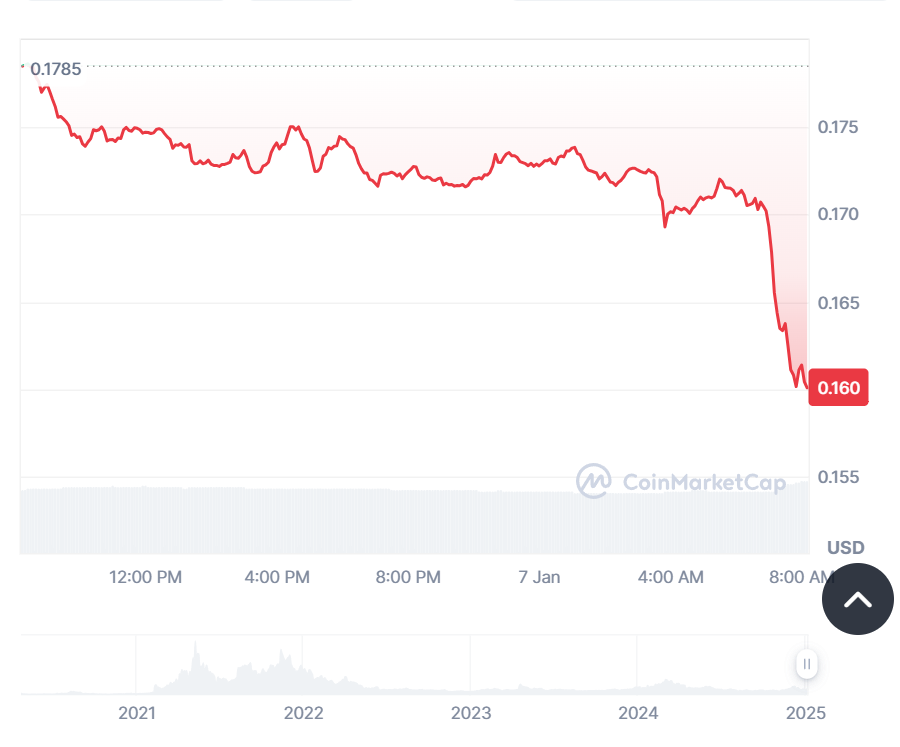







































Cartesi Price Prediction 2025-2031: Is CTSI a Good Investment?
 CONV
CONV BULLISH
BULLISH VALU
VALU CTSI
CTSI DAILY
DAILYKey takeaways
- By 2025, the CTSI price could reach a maximum of $0.2854.
- In 2028, the price of Cartesi is predicted to reach a maximum level of $0.8087.
- Cartesi is expected to cross a price level of $2.47 in 2031.
Developers can now write code for dApps and create complex and straightforward smart contracts using Linux architecture on Cartesi. This feature inducts conventional programmers into the blockchain ecosystem to code smart contracts using Ruby, Python, REST, MongoDB, Eigen, MySQL, Nginx, Libsnark, and Linux.
Cartesi’s real-world use cases make it appealing to potential investors. Let’s learn more about the Cartesi (CTSI) project, its uniqueness, its technical analysis, historical data, and market price predictions.
Overview
| Cryptocurrency | Cartesi |
| Token | CTSI |
| Price | $0.1702 |
| Market Cap | $143.79M |
| Trading Volume | $14.51M |
| Circulating Supply | 843.5M CTSI |
| All-time High | $1.75 May 08, 2021 |
| All-time Low | $0.02675 May 09, 2020 |
| 24-h High | $0.1787 |
| 24-h Low | $0.1716 |
Cartesi price prediction: Technical analysis
| Metric | Value |
| Price Prediction | $ 0.158605 (-6.70%) |
| Volatility | 13.21% |
| 50-Day SMA | $ 0.182752 |
| 14-Day RSI | 52.97 |
| Sentiment | Neutral |
| Fear & Greed Index | 78(Greed) |
| Green Days | 14/30 (47%) |
| 200-Day SMA | $ 0.155447 |
Cartesi coin price analysis: CTSI faces downward pressure, tests $0.1460 support
Key takeaways
- Cartesi coin price analysis shows a downtrend
- Cartesi technical indicators signal a downward continuation
- The 0.1460 level is the nearest short-term support, while the 0.1560 region is a pivotal resistance.
Cartesi coin price analysis for January 9th shows Cartesi’s price descended sharply indicating a noticeable surge in selling pressure. This move may have been influenced by broader market uncertainty, which rattled the confidence of short-term traders. Notably, the coin did manage to recover slightly, climbing above 0.1500 and illustrating buyers’ eagerness to reclaim momentum. While this bounce is a positive sign, the price remains below its recent highs, signaling that bulls need additional catalysts to push the token toward stronger gains.
From a technical standpoint, the 0.1460 level is the nearest short-term support, while the 0.1560 region stands as a pivotal resistance. A sustained break below 0.1460 could pave the way for deeper losses, whereas a decisive push beyond 0.1560 might solidify a more robust recovery.
Cartesi daily chart analysis: Bears in control as indicators signal caution
The daily chart for Cartesi presents a noticeable bearish trend as reflected in the recent price movements and key technical indicators. The Moving Average Convergence Divergence (MACD), which helps identify price momentum and trend reversals, is currently hovering around the zero line with the MACD line slightly above the signal line, suggesting a weak bullish momentum. However, the proximity to the zero line also signals caution, as it may indicate a lack of strong buying pressure. The price of Cartesi has notably decreased, closing at $0.1507, which marks a 3.40% decline. This recent drop further aligns with the bearish sentiment suggested by the MACD.
The Relative Strength Index (RSI), another critical tool used to determine whether an asset is overbought or oversold, stands at 38.78. This level indicates that Cartesi is neither in the oversold nor overbought territory, but it leans towards a bearish bias as it trends downwards from the mid-line (50). The RSI’s downward trajectory suggests that the selling pressure is not fully exhausted, potentially leading to further declines if the bearish momentum continues. Investors and traders should keep an eye on these indicators for potential shifts in momentum or further confirmation of the prevailing downtrend.
Cartesi 4-hour chart analysis: Consolidation amid bearish pressure
The 4-hour chart for Cartesi demonstrates a short-term consolidation phase following a strong bearish trend. The price is trading below key moving averages, including the 20-day and 50-day Simple Moving Averages (SMAs), which currently act as resistance levels at $0.1612 and $0.1664, respectively. The downward slope of these SMAs confirms the prevailing bearish sentiment, while the price of $0.1507 indicates that sellers maintain dominance in this timeframe. The MACD histogram shows declining bullish momentum, with the MACD line dipping closer to the signal line, suggesting a potential crossover that could reignite selling pressure.
The MA Ribbon further reinforces the bearish outlook, with the price trading significantly below the longer-term moving averages, such as the 100-day and 200-day SMAs. This positioning signals a lack of immediate recovery potential unless substantial buying volume enters the market. While the short-term support level appears to hold near $0.1450, failure to sustain above this level may result in further declines toward previous lows. Traders should watch for a decisive MACD crossover and increased volume for clearer directional cues.
Cartesi technical indicators: Levels and action
Daily simple moving average (SMA)
| Period | Value | Action |
| SMA 3 | $ 0.189762 | SELL |
| SMA 5 | $ 0.187202 | SELL |
| SMA 10 | $ 0.171334 | SELL |
| SMA 21 | $ 0.166437 | BUY |
| SMA 50 | $ 0.182752 | SELL |
| SMA 100 | $ 0.157044 | BUY |
| SMA 200 | $ 0.155447 | BUY |
Daily exponential moving average (EMA)
| Period | Value | Action |
| EMA 3 | $ 0.167421 | BUY |
| EMA 5 | $ 0.17332 | SELL |
| EMA 10 | $ 0.184813 | SELL |
| EMA 21 | $ 0.191834 | SELL |
| EMA 50 | $ 0.180063 | SELL |
| EMA 100 | $ 0.16645 | BUY |
| EMA 200 | $ 0.166883 | BUY |
What to expect from Cartesi?
Cartesi’s recent price action reflects a bearish trend characterized by sustained selling pressure and weak bullish momentum, as evident from its daily and 4-hour chart analyses. The price’s struggle to hold above $0.1500 and its proximity to critical support at $0.1460 highlight the vulnerability to further declines if selling pressure persists. Key technical indicators such as the MACD and RSI signal caution, with the former suggesting weak bullish momentum near the zero line and the latter trending towards bearish territory below the midline. The price’s position below crucial moving averages further confirms bearish dominance, with resistance levels at $0.1560 and above indicating significant hurdles for recovery. To reverse this downtrend, Cartesi requires a decisive breakout above $0.1560 and strong buying volume to counter the prevailing negative sentiment.
Is Cartesi a good investment?
Investing in Cartesi (CTSI) offers a promising opportunity due to its innovative approach, which integrates a full Linux environment for blockchain developers. This unique feature lowers barriers to entry and broadens the potential for more sophisticated decentralized applications (DApps). Additionally, the launch of Noether’s Staking Delegation, backed by rigorous audits and testing, underscores Cartesi’s commitment to security and scalability. Cartesi’s modular Rollups—usable as Layer 2, Layer 3, or sovereign rollups—further enhance its appeal by providing flexible and scalable solutions, positioning it as a strong contender in the evolving blockchain landscape.
Will CTSI recover?
The recovery of Cartesi (CTSI) will depend on broader market conditions, positive developments within the Cartesi project, and overall investor sentiment. If the cryptocurrency market turns bullish, Cartesi could launch successful new features or partnerships and gain increased usage, which could boost investor confidence and drive a price recovery.
Will Cartesi reach $1?
Based on long-term forecasts, Cartesi is projected to reach $1 by 2029 as its ecosystem and user adoption continue to grow.
Will Cartesi reach $10?
Reaching $10 is an ambitious but more plausible target for Cartesi (CTSI) compared to $100, yet it still requires significant growth and development.
Will Cartesi reach $100?
Reaching $100 would be an extremely ambitious target for Cartesi (CTSI), requiring unprecedented growth and adoption, and therefore unlikely.
Does CTSI have a good long-term future?
Cartesi (CTSI) has the potential for a strong long-term future due to its unique value proposition of integrating Linux and standard programming environments with blockchain technology, which could attract developers looking for more versatile and familiar tools.
Cartesi price prediction January 2025
The Cartesi price in January 2025 shows that the minimum trading cost might be $0.1634, while the maximum might reach $0.1838 this month. On average, the value of CTSI is expected to be around $0.1787.
| Cartesi Price Prediction | Potential Low | Potential Average | Potential High |
| Cartesi Price Prediction January 2025 | $0.1634 | $0.1787 | $0.1838 |
Cartesi price prediction 2025
The Cartesi price is forecast to reach the lowest possible level of $0.2340 in 2025. According to the findings, the CTSI price could reach a maximum possible level of $0.2854, with an average forecast price of $0.2425.
| Cartesi Price Prediction | Potential Low | Potential Average | Potential High |
| Cartesi Price Prediction 2025 | $0.2340 | $0.2425 | $0.2854 |
Cartesi Price Prediction 2026-2031
| Year | Minimum | Average | Maximum |
| 2026 | $0.3334 | $0.3455 | $0.4047 |
| 2027 | $0.4610 | $0.4782 | $0.5808 |
| 2028 | $0.6777 | $0.7016 | $0.8087 |
| 2029 | $0.9943 | $1.03 | $1.18 |
| 2030 | $1.44 | $1.48 | $1.70 |
| 2031 | $2.06 | $2.13 | $2.47 |
CTSI price prediction 2026
According to Cartesi’s price projection and technical analysis, the CTSI price is predicted to cross an average price level of $0.3455 in 2026, with a minimum price value of $0.3334. Furthermore, CTSI has a maximum price of $0.4047.
Cartesi price prediction 2027
According to the forecast price for 2027, the price of Cartesi is predicted to reach a minimum level of $0.4610. The CTSI price can reach a maximum level of $0.5808, with an average trading price of $0.4782.
Cartesi CTSI price prediction 2028
.In 2028 the price of Cartesi is predicted to reach a minimum level of $0.6777. The CTSI price can reach a maximum level of $0.8087 with an average trading price of $0.7016.
Cartesi price prediction 2029
In 2029, the price of Cartesi is forecasted to be around a minimum value of $0.9943. The price can reach a maximum of $1.18, with an average trading value of $1.03.
Cartesi price prediction 2030
Cartesi’s price projection shows that CTSI is predicted to cross an average price level of $1.48 in 2030, with a minimum price value of $1.44. Furthermore, CTSI has a maximum price of $1.70.
Cartesi price forecast 2031
The Cartesi price is forecast to reach its lowest possible level of $2.06 in 2030. According to the findings, the CTSI price could reach a maximum possible level of $2.47, with an average forecast price of $2.13.
Cartesi market price prediction: Analysts’ CTSI price forecast
| Firm Name | 2025 | 2026 |
| Gov.Capital | $0.18 | $0.201 |
| DigitalCoinPrice | $0.36 | $0.42 |
| CoinCodex | $ 0.1699 | $ 0.2249 |
Cartesi price prediction by Cryptopolitan
According to Cryptopolitan, CTSI will experience tremendous growth as it can achieve new highs in price points and market cap. Meanwhile, Cartesi is expected to reach a minimum price of $0.2340. The maximum price may reach $0.2854 in 2025.
Cartesi (CTSI) historic price sentiment

- In April 2020, Cartesi’s public trading kicked off with an opening price of $0.05717. The price fell to $0.02675 in May 2020, an all-time low.
- Towards the end of May 2020, the CTSI price rose above the $0.03 mark and traded within $0.03 – $0.04 until June 2020.
- On August 18, 2020, Cartesi’s price reached a year-high market price of $0.1298, but the momentum fizzled out, and the price dropped to $0.02683 on October 30.
- Before the turn of 2021, CTSI made some recoveries, and its price jumped as high as $0.06217 in December 2020.
- The positive momentum continued in January 2021, and its market price surged to an all-time high of $1.75 on May 09, 2021.
- Afterwards, the price of CTSI fell and then jumped to $1.25 on August 9, 2021. Currently, Cartesi is trading at $0.625, with a market cap of over $260 million and a 24-hour trading volume of over $31 million.
- In January 2022, the price decreased to around $0.50, indicating a market correction or a period of reduced trading activity.
- The price stabilized around $0.20 in July 2022, suggesting a period of consolidation where buying and selling pressures were balanced.
- In October 2023, the price remained stable at around $0.15, indicating another period of consolidation.
- In 2024, the cryptocurrency price ranged between $0.14 and $0.20. It rose to $0.20 in January, dropped to $0.14 by April, and remained stable mid-year. From August to October, it fluctuated narrowly between $0.15 and $0.20, with slight upward momentum in December, briefly exceeding $0.20.
- In January 2025, the price settles around $0.15 as the most recent value, indicating either market corrections or consistent demand levels.

